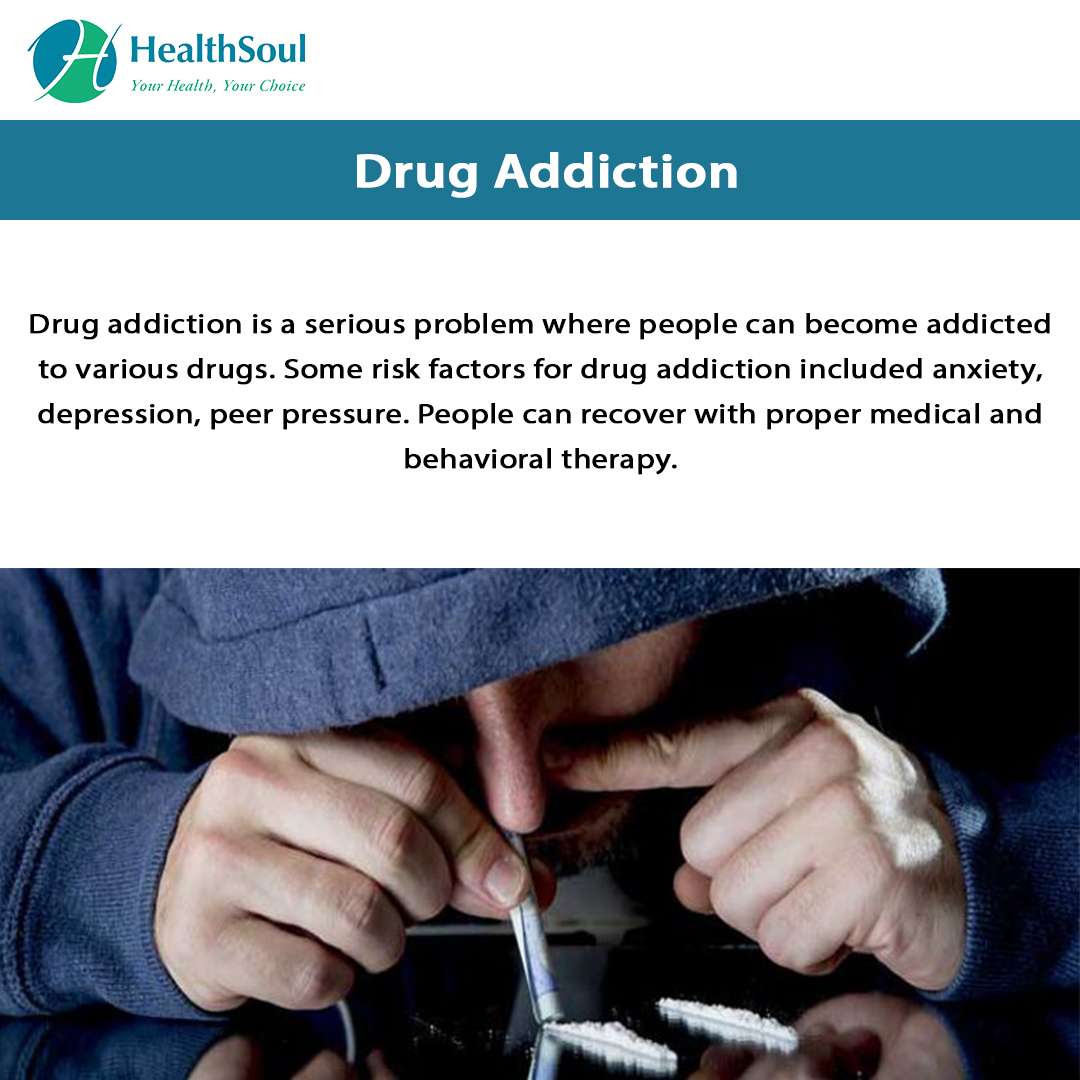What Else Should I Ask My Healthcare Provider
If you or a loved one is experiencing substance use disorder, ask your healthcare provider:
- How can I stop taking drugs?
- What is the best treatment plan for me?
- How long will the withdrawal symptoms last?
- How long does therapy take?
- What can I do to prevent a relapse?
- What community resources can help me during my recovery?
A note from Cleveland Clinic
Substance abuse, or substance use disorder, is a brain disease. Drugs affect your brain, including your decision-making ability. These changes make it hard to stop taking drugs, even if you want to. If you or a loved one has a substance use disorder, talk to a healthcare provider. A trained provider can help guide you to the treatment you need. Usually, a combination of medication and ongoing therapy helps people recover from addiction and get back to their lives.
Last reviewed by a Cleveland Clinic medical professional on 09/03/2020.
References
Who Is At Risk For Substance Use Disorder
Anyone can develop a substance use disorder. No one thing can predict whether a person may develop an addiction. You may be more prone to drug use due to:
- Biology: The persons genetic makeup, gender, ethnicity and mental health issues may raise his or her risk for developing an addiction. About two-thirds of people in addiction treatment are men. Particular ethnicities are at higher risk for substance abuse disorder. This is true for Native Americans.
- Environment: Surroundings can affect the likelihood of developing substance use disorder. For example, stress, peer pressure, physical or sexual abuse and early exposure to drugs can raise the risk.
- Age: Teenagers who start taking drugs are especially at risk. The parts of the brain that control judgment, decisions and self-control are not fully developed. Teens are more likely to engage in risky behaviors. In a developing brain, drugs can cause changes that make addiction more likely.
Why Do Some People Become Addicted To Drugs While Others Don’t
No one factor can predict if a person will become addicted to drugs. A combination of factors influences risk for addiction. The more risk factors a person has, the greater the chance that taking drugs can lead to addiction. For example:
- Biology. The genes that people are born with account for about half of a person’s risk for addiction. Gender, ethnicity, and the presence of other mental disorders may also influence risk for drug use and addiction.
- Environment. A persons environment includes many different influences, from family and friends to economic status and general quality of life. Factors such as peer pressure, physical and sexual abuse, early exposure to drugs, stress, and parental guidance can greatly affect a persons likelihood of drug use and addiction.
- Development. Genetic and environmental factors interact with critical developmental stages in a persons life to affect addiction risk. Although taking drugs at any age can lead to addiction, the earlier that drug use begins, the more likely it will progress to addiction. This is particularly problematic for teens. Because areas in their brains that control decision-making, judgment, and self-control are still developing, teens may be especially prone to risky behaviors, including trying drugs.
Also Check: How Do You Treat Addiction
Statistics On Opioid Addiction And Abuse
Opioids are a class of drugs which block sensations of pain and cause euphoria. They are dangerous because they pose very high risks for addiction and overdose. Opioids are an ingredient in many pain-relieving medications. Since they are controlled substances, drug traffickers also sell them illegally. Opioids, both illegal and prescribed, have caused a surge of deaths in the United States in the past 2 decades.
- About 130 Americans die every day from an Opioid overdose.
- From 1999 to 2017, 399,230 Americans lost their lives to Opioids.
- In 2017 alone, 47,600 fatal overdoses occurred in America which involved at least 1 Opioid.
- In 2017, doctors issued 191,218,272 Opioid prescriptions, a slight decline from the 200,000,000 Opioid prescriptions which they issued every year from 2006 to 2016.
- Since 1999, the sale of Opioid painkillers has skyrocketed by 300%.
- About 20% to 30% of people who take prescription Opioids misuse them.
- 2 million Americans misused prescription Opioids for the first time in 2017.
- About 10% of people who misuse prescription Opioids become addicted to Opioids.
- Approximately 2.1 million Americans have an Opioid use disorder.
- About 5% of people with an Opioid use disorder will try Heroin.
Statistics On Tobacco Addiction And Abuse

In most states, anyone over the age of 18 can easily purchase a box of cigarettes. Although cigarettes are legal and accessible, they cause a variety of fatal health conditions and they are also addictive.
- About 34 million Americans smoke cigarettes.
- The percentage of Americans who smoke cigarettes has decreased from 21% in 2005 to 14% in 2017.
- About 16% of American men and about 12% of American women smoke cigarettes.
- People who are disabled, live below the poverty line, or lack a college education are more likely to smoke cigarettes.
- In 2017, about 604,000 Americans between the ages of 12 and 17 and about 1.2 million Americans between the ages of 18 and 21 smoked their first cigarette.
- Smoking cigarettes is the cause of over 480,000 deaths every year in the United States.
Also Check: How Long Does It Take To Detox From Alcohol Addiction
Help Is Available For The Families Of Addicts
Having a family member with an addiction problem is painful, confusing, and overwhelming. The situation is not hopeless, though. Treatment facilities can help people with substance abuse problems and the families who love them.
If you want to know how to get someone into rehab, we can help you. Peace Valley Recovery provides well-rounded, comprehensive addiction treatment programs. If your loved one wants to stop using drugs and alcohol, we can help.
We know the pain of caring for someone who cant stay clean and sober and we are here for you. Call us at today to speak with an admissions counselor who can answer any questions. You dont have to walk this path alone!
Can I Prevent Substance Use Disorder
Yes. Preventing drug addiction starts with education. Education in schools, communities and families helps prevent misusing a substance for the first time. Other ways to prevent substance use disorder:
- Dont try illegal drugs, even one time.
- Follow instructions for prescription medications. Don’t ever take more than instructed. Opioid addiction, for instance, can start after just five days.
- Dispose of unused prescriptions promptly to reduce risks of misuse by others.
You May Like: Why Is Alcohol So Addictive
Can Addiction Come Back
Substance use disorder is a relapsing disease. People who are in recovery from this disease have a higher chance of using drugs again. Recurrence can happen even years after you last took drugs.
Because of the possibility of relapse, you need ongoing treatment. Your healthcare provider should review your treatment plan with you and change it based on your changing needs. If you have a problem with prescription drugs, including opioids, inform your healthcare providers. They can help you find other options to manage pain.
Statistics On Methamphetamine Addiction And Abuse
Methamphetamine, which is commonly called Meth, is a controlled substance which has a high potential for abuse, overdose, and addiction. As an illegal drug, Meth is usually sold as Crystal to be burned and smoked. Meth is highly addictive and dangerous for a persons health.
- About 774,000 Americans are regular Meth users. About 16,000 of them are between the ages of 12 and 17.
- About 10,000 Americans who regularly used Meth suffered a fatal overdose in 2017.
- About 964,000 Americans are addicted to Meth.
- In 2017, about 195,000 Americans used Meth for the first time.
- The number of fatal Meth overdoses almost tripled from 2011 to 2016.
You May Like: What Types Of Addictions Are There
How Does Your Brain Communicate
The brain is a complex communications network of billions of neurons, neurotransmitters, and receptors. Networks of neurons pass messages back and forth thousands of times a minute within the brain, spinal column, and nerves. These nerve networks control everything we feel, think, and do. For example, when you want to go up the stairs, this message system will tell you to lift your foot onto the first step and so on. Understanding these networks helps scientists learn how drugs affect the brain. The networks are made up of:
Hepatitis C Virus And Human Immunodeficiency Virus
A May 2015 MMWR article reports an increase in the number of persons in the U.S. living with HCV, particularly with young adults under 30 years old. Increases are most noticeable in nonurban areas of Appalachia where injection drug use has been identified as the primary risk factor for HCV. Approximately 73% of the reported HCV cases in this area were contracted by people reporting IDU.
Although not as prevalent in injection drug users as HCV, HIV infections can potentially increase concurrently with HCV because the risk factors are similar. HIV and HCV are blood-borne diseases that are effectively transmitted through the use of contaminated needles and equipment used for preparing drugs, according to a November 2012 MMWR article. A 2010 study published in the journalAddiction has shown the prevalence of HCV can be an indicator of HIV risk among injecting drug users.
Also Check: Can You Get Addicted To Crack
What Other Factors Increase The Risk Of Addiction
- Early use. Although taking drugs at any age can lead to addiction, research shows that the earlier people begin to use drugs, the more likely they are to develop serious problems.31 This may be due to the harmful effect that drugs can have on the developing brain.32 It also may result from a mix of early social and biological risk factors, including lack of a stable home or family, exposure to physical or sexual abuse, genes, or mental illness. Still, the fact remains that early use is a strong indicator of problems ahead, including addiction.
- How the drug is taken. Smoking a drug or injecting it into a vein increases its addictive potential.33,34 Both smoked and injected drugs enter the brain within seconds, producing a powerful rush of pleasure. However, this intense high can fade within a few minutes. Scientists believe this powerful contrast drives some people to repeatedly use drugs to recapture the fleeting pleasurable state.
What Are Symptoms Of Substance Use Disorder

Symptoms of drug addiction include:
- Bloodshot eyes and looking tired.
- Changes in appetite, usually eating less.
- Changes in physical appearance, such as having a poor complexion or looking ungroomed.
- Craving drugs.
- Difficulty completing tasks at work, school or home.
- Engaging in risky behaviors, despite knowing negative consequences .
- Inability to reduce or control drug use.
- Issues with money.
Recommended Reading: How Addictive Is Nicotine By Itself
Statistics On Cocaine Addiction And Abuse
Cocaine is an illegal Stimulant. Whether it comes in the form of powder or crystal , Cocaine can damage organs, provoke mental disorders, and cause respiratory failure. Cocaine is also highly addictive. Some Cocaine users may become addicted after using the drug only once.
- About 5 million Americans are regular Cocaine users.
- In 2017, 2.2 million Americans used Cocaine at least once the previous month.
- Cocaine was involved in 1 out of every 5 overdose deaths in 2017.
- The percentage of Cocaine-related overdose deaths increased by 34% from 2016 to 2017.
- Americans between the ages of 18 to 25 use Cocaine more than any other age group.
- In 2017, 1 million Americans above the age of 12 used Cocaine for the first time.
- In 2018, almost 4% of 12th graders admitted to having used Cocaine at least once in their lives.
Drug Abuse Financial Costs
In 2020, the National Drug Control Budget requested $34.6 billion across five areas of drug control functions: operations, prevention, treatment, interdiction, and law enforcement).
- $1.2 billion to Department of Defense for counterdrug operations at home and abroad.
- $55.5 million to Department of Education for school climate transformation grants for school-based substance abuse prevention/technical assistance.
- $1.5 billion to SAMSHA for State Opioid Response grants intended for tribes, states, and US territory.
- $1.9 billion to SAMSHA for Substance Abuse Prevention and Treatment Block Grant to fund evidence-based prevention activities for states, tribes and territories.
- $620 million to HRSA community health centers.
- Other recipients include the Departments of Homeland Security, Housing and Urban Development, Justice, Labor, State, Transportation, Treasury, Veterans Affairs, etc.
Recommended Reading: How To Control An Addictive Personality
What Is Drug Use
Drug use, or misuse, includes
- Using illegal substances, such as
- Misusing prescription medicines, including opioids. This means taking the medicines in a different way than the health care provider prescribed. This includes
- Taking a medicine that was prescribed for someone else
- Taking a larger dose than you are supposed to
- Using the medicine in a different way than you are supposed to. For example, instead of swallowing your tablets, you might crush and then snort or inject them.
- Using the medicine for another purpose, such as getting high
- Misusing over-the-counter medicines, including using them for another purpose and using them in a different way than you are supposed to
Drug use is dangerous. It can harm your brain and body, sometimes permanently. It can hurt the people around you, including friends, families, kids, and unborn babies. Drug use can also lead to addiction.
Drug Abuse Among Veterans
Mental illness and substance abuse is relatively common among military veterans.
- 7% of veterans struggle with illegal drug use compared to 5.3% of the general population in the US over age 18.
- 80% struggle with alcohol abuse, and 7% have an issue with both alcohol and illegal drugs.
- 7% of the veteran population has a serious mental illness compared to 14.4% of adults over 18.
- 505,000 veterans misuse prescription pain relievers compared to 59,000 who used heroin.
- 10% of veterans between the ages of 18-25 misuse prescription pain relievers compared to 5.5% of the general population in the US in the same age group.
Also Check: How To Break Phone Addiction
Dependence Addiction & Mental Health
Non-sanctioned/non-medical/non-prescribed use of these controlled substances is considered drug abuse. They are likely to create physical or psychological dependence.
- Substance Abuse Disorders affect over 20 million Americans aged 12 and over.
- Most common disorders were related to marijuana and prescription pain relievers.
- Major Depressive Episodes affect 3.5 million adolescents and 4.6 million young adults nationwide.
- 1 million or 19.1% of adults have a mental illness.
- 4 million or 4.6% of adults have a serious mental illness.
- 358,000 or 1.5% of all adolescents in the US have had both an SUD and an MDE within the last year.
- 1.2% of all adolescents had both an SUD and MDE resulting in severe impairment.
- 8.5% of adolescents with MDE were more likely to binge drink than those without .
- 32.7% of adolescents with ME were more likely to use an illegal drug than those without .
- Among adolescents with both an MDE and SUD, 65.7% received either substance abuse treatment at a specialty facility or mental health services.
What Is The Current Status Of Methamphetamine Use In Rural America And What Has Been Done To Combat Its Use And Production
According to SAMHSA’s Results from the 2019 National Survey on Drug Use and Health: Detailed Tables, the rate of methamphetamine use by young rural adults ages 1825 was 0.7% for large metro areas, 0.8% for small metro areas, 1.4% for nonmetro areas. This pattern of higher use in rural areas continues to be a great concern.
According to the Drug Enforcement Administration report, 2019 National Drug Threat Assessment Summary, police reports for methamphetamine has risen 87% since 2010 and had gone from 8% of all drug reports in 2009 to 40% in 2017. Although seizures of covert meth labs in the U.S have decreased, availability is still high due to foreign production and the proliferation of small, one pot, or shake-and-bake laboratories, which are harder to track down. Admissions for amphetamine-related treatment continue to increase.
The Meth Project Foundation, Inc. is a national program of The Partnership for Drug-Free Kids that focuses on reducing methamphetamine use through public service media, outreach programs, and the development of public policy. It also is a source of information for youth about meth.
Also Check: Why Am I So Addicted To Weed
Sentencing By State 2
have led to overcrowded facilities, skyrocketing prison costs, and major social, economic, and political impacts. Currently, nearly half of all inmates in federal prisons are serving sentences for drug offenses. Many are fathers and mothers who miss …
pictureheroin-business-dealers-dea/11706937
What Does All This Mean

All drugs have the potential for abuse and addiction. This is why ANY experimentation or recreational use can be dangerous because that can be a rapid, slippery slope down a treacherous path to full-blown addiction.
All of this information also goes to show that addiction can happen to ANYONE a friend, a family member, or even YOU.
You May Like: What Drugs Are The Most Addictive
United Kingdom Drug Situation 201: Summary
This publication is licensed under the terms of the Open Government Licence v3.0 except where otherwise stated. To view this licence, visit nationalarchives.gov.uk/doc/open-government-licence/version/3 or write to the Information Policy Team, The National Archives, Kew, London TW9 4DU, or email: .
Where we have identified any third party copyright information you will need to obtain permission from the copyright holders concerned.
This publication is available at https://www.gov.uk/government/publications/united-kingdom-drug-situation-focal-point-annual-report/uk-drug-situation-2019-summary
